Plaxton is an English builder of bus and coach vehicle bodies based in Scarborough. Founded in 1907 by Frederick William Plaxton, it became a subsidiary of Alexander Dennis in May 2007. In 2019, the maker was acquired by Canadian bus manufacturer New Flyer which then became NFI Group.

Seddon Atkinson Vehicles Limited, a manufacturer of large goods vehicles based in Oldham, Greater Manchester, England, was formed after the acquisition in 1970 of Atkinson Vehicles Limited of Preston by Seddon Diesel Vehicles Limited of Oldham. In 1974, the firm was acquired by International Harvester, which sold it in March 1984 to the Spanish group Enasa which made it a subsidiary of Pegaso. In 1990, it became part of Iveco which used the brand for various types of specialised vehicles in the United Kingdom. The range of models produced included EuroMover, Pacer and Strato, which are aimed at refuse collection, recycling and construction operators.

A midibus is a classification of single-decker minibuses which are generally larger than a traditional minibus but smaller than a full-size single decker and can be anywhere between 8 metres and 11 metres long. While used in many parts of the world, the midibus is perhaps most common in the United Kingdom, where operators have found them more economical, and to have a sufficient number of seats compared to full size single-decker buses.

Duple Coachbuilders was a coach and bus bodybuilder in England from 1919 until 1989.

The Leyland Leopard was a mid-engined single-decker bus and single-decker coach chassis manufactured by Leyland between 1959 and 1982.

Barton Transport was a bus company that operated in Nottinghamshire from 1908 until 1989.
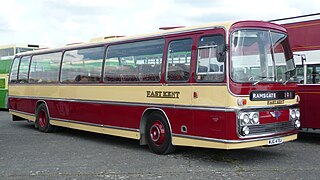
The Plaxton Panorama Elite was a successful design of coach bodywork built between 1968 and 1975 by Plaxton of Scarborough, Yorkshire, England. A wide-doorway variant called the Plaxton Elite Express was also built. Collectively, they are commonly referred to as the Plaxton Elite.

The Plaxton Paramount was a design of coach bodywork built by Plaxton. It first appeared at the 1982 British Motor Show and was built until 1992.

The Plaxton Premiere, Plaxton Excalibur and Plaxton Prima were closely related designs of coach bodywork built by Plaxton.

The Duple Dominant was a design of a coach bodywork built by Duple between 1972 and 1987. It introduced an all-steel structure and replaced the wooden-framed Duple Vega, Viceroy and Vista models.

Thomas Harrington & Sons was a coachbuilder in the county of Sussex from 1897 until 1966, initially at Brighton but from 1930 until the end in a purpose built Art Deco factory in Old Shoreham Road, Hove.
Gibson's of Moffat was a bus and coach operator in Dumfries & Galloway, Scotland. It is no longer in business.
H. V. Burlingham was a British coachbuilding business based in Blackpool, Lancashire from 1928 until 1960 when they were taken over by London-based rivals Duple Motor Bodies. Duple initially renamed Burlingham as Duple (Northern) but in 1969 they closed their Hendon factory and concentrated production in Blackpool. Duple coach bodies were built in the former Burlingham premises until Duple itself was liquidated in 1989.

The Seddon Pennine 7 was a mid-underfloor-engined single-deck bus or coach chassis built by Seddon Atkinson between 1974 and 1982.

The Leyland Royal Tiger Worldmaster, sometimes simply known as the Leyland Worldmaster, was a mid-underfloor-engined single-decker bus or single-decker coach chassis manufactured by Leyland between 1954 and 1979.
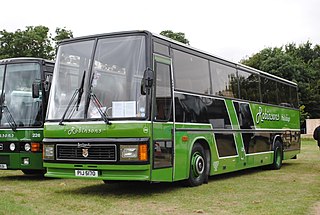
The Duple Caribbean was design of a coach bodywork built by Duple between 1983 and 1986. It replaced the high-floor Goldliner variant of the long-running Duple Dominant range as Duple's premium coach body of the mid 1980s.
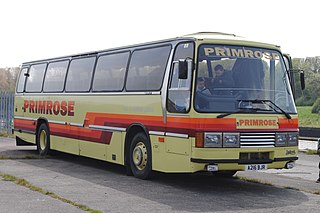
The Duple Laser was a design of a coach bodywork built by Duple between 1983 and 1986. It replaced the long-running Duple Dominant body as Duple's standard medium-height coach of the mid 1980s.
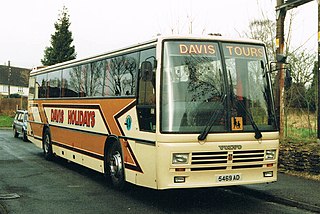
The Duple 300 Series were a range of bus and coach bodywork built by Duple between 1985 and 1989. The range comprised the 3,000 mm high Duple 300 service bus, the 3,200 mm high Duple 320 coach, and the taller 3,400 mm high Duple 340 coach. The 320 and 340 coaches were announced at the Bus and Coach Show at Earls Court in September 1985 as replacements for the previous Laser and Caribbean. Deliveries of these models commenced in 1986, whilst the 300 bus was launched in 1987 as a replacement for the Dominant Bus. After Duple closed down the designs were sold to Plaxton and a small number of additional 320 bodies were built as the Plaxton 321.
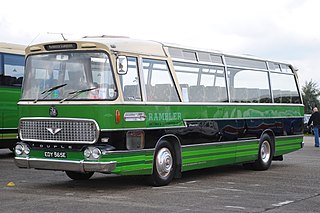
The Duple Viceroy was a type of coach bodywork built by Duple between 1966 and 1972. It was initially launched on lightweight front-engined chassis, but it was latterly built on mid-engined and heavyweight chassis as well. A variant of the Viceroy was the Duple Viceroy Express, which had a bus-type entrance door making it suitable for stage carriage work.





























